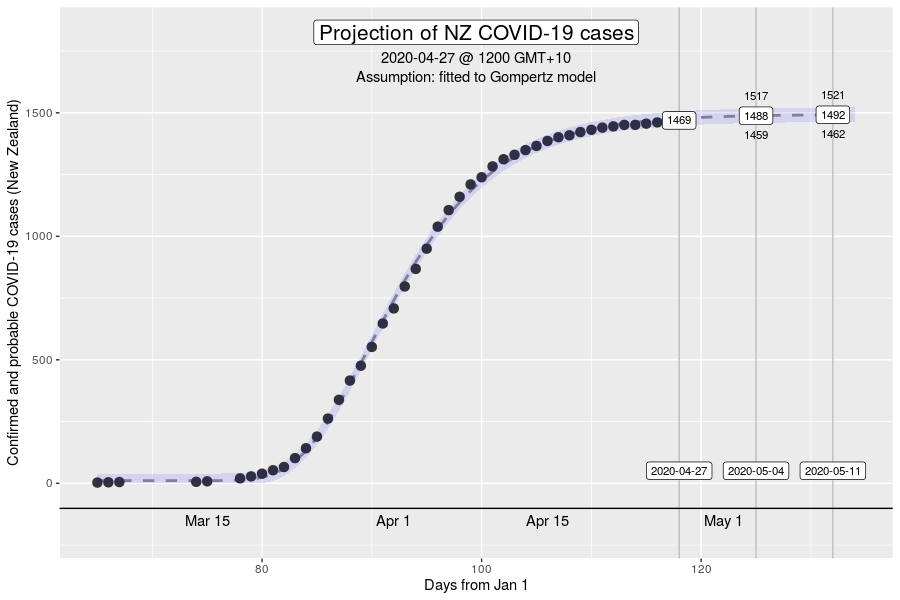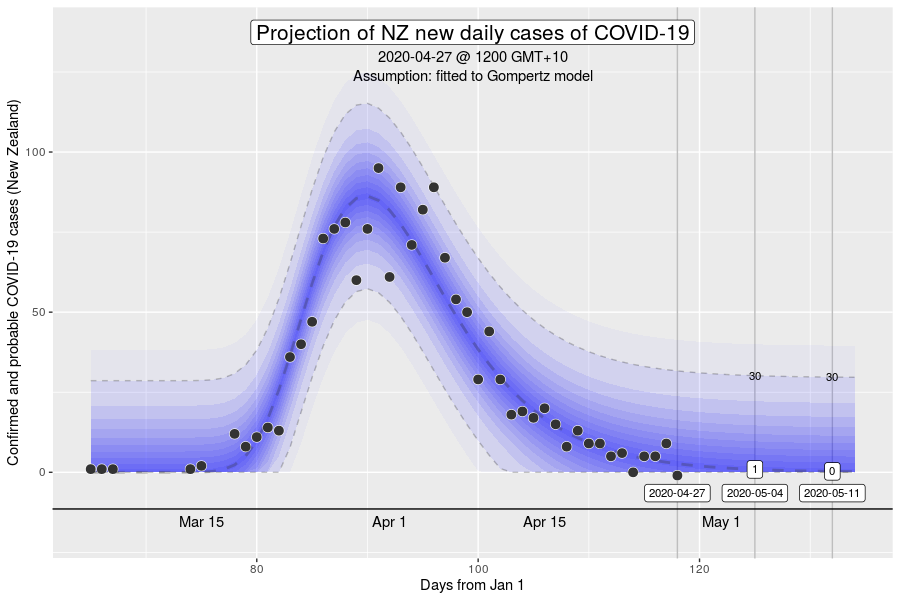I restarted the analyses from early July 2020 with the onset of the new Melbourne outbreak. The logic behind these charts is that they fill an information gap. Official data sources only give historic data series, and mainstream media typically only give near term predictions based on opinion.
Chart update 27 July 2020
What’s new?
Today’s new number of cases, 549 as per the Australian Department of Health 27/7/2020 update is somewhat higher than the projected estimate of the model. There have been large day-to-day fluctuations in the past week. Given the lower than expected case counts over the last 2-3 days, perhaps today’s count, though disappointing, is not unexpected. The overall model projections remain stable, and some of this relates to the downwards revision of some of the case counts from the recent past days in the Department of Health updates.
We are now over two weeks into the stage 3 restrictions (“lock down”) of Melbourne, which started on 9 July 2020. According to the model, the peak in new cases is about a fortnight away. If some of the policies commenced in Melbourne are effective are reducing transmission further (e.g., mandatory use of face coverings), the model may be (hopefully) providing over-estimates and the peak will arrive sooner.
My experience with this model from the March 2020 was that projections from early on in the epidemic tend to underestimate slightly in the short-term (days), and overestimate in the longer-term (weeks). This bias is something to keep in mind.
Projection of new daily cases of COVID-19 with data up to 27 July 2020
What is this?
The image is a chart of the confirmed daily new cases of COVID-19 in Australia, with a projection for the next 2 weeks. The projection is made using a model by fitting the data since 1 June 2020 to a Gompertz equation using non-linear regression. The dark blue dashed line is the model estimate. The grey dashed lines are the 95% prediction intervals, with the values given at 7 and 14 days into the future. The blue gradations can be understood as the degree of uncertainty in the model projections.
“Gompertz” equation?
The Gompertz function is a type of sigmoid, or “S”-shaped curve. It’s been around since the early 19th century and was initially used to describe and model demographic mortality curves, and hence, well known to actuaries. The Gompertz function can also be used to accurately model biological growth (e.g., epidemics, tumour size, enzymatic reactions). I have chosen to use this model to help with creating insights as earlier in the pandemic, it was found to be useful in modelling cumulative cases of COVID-19 from the Chinese outbreaks (Jia et al. arXiv:2003.05447v2 [q-bio.PE]). My experience from the initial outbreak from earlier in the year was that this equation gave reasonable descriptions of Australian and New Zealand data (for instance, NZ data below).


How have the model projections changed over the month?
The video demonstrates how the projections have evolved over time as new daily data have become available. This can give a better sense of where we are headed, given that the model cannot account for changes in context (e.g., policy changes, changes in testing rates, etc.)
My interpretation
Today’s case count is higher than projected by the model, but the model remains stable. It is clear that the current outbreak has not responded to policy interventions as quickly as the outbreak in March-April. However, in the past week, the model has had a downwards change in the overall projections – with a lower peak that has moved closer to the present. Today’s case count has largely not had an effect on these projections. These are hopeful signs, though we will need to watch and wait to see whether it is an ongoing trend.
There remains concern with the daily number of cases in NSW at multiple locations across Sydney and the state. Although new daily numbers haven’t climbed in the past week, the most parsimonious explanation remains hidden community transmission, originating from the Melbourne outbreak. Widespread testing and contact tracing is taking place, along with improving physical distancing adherence and use of masks. Hopefully, it will be enough.
More information about the “peak” in new cases
According to the current model, the peak will arrive in about a fortnight in early to mid-August at around 500 cases per day. It should be noted that projections at two weeks and beyond have high uncertainty and should be interpreted with caution.
What does it mean to have reached the peak in new cases? It’s important to recognise that although this is a welcome milestone in an outbreak, it is not the “half-way point”, which might be the intuition. The peak in the “new cases” curve corresponds to the “inflexion point” on the S-shaped culmulative cases curve (e.g., the first chart of the NZ cases in the brief description on the “Gompertz equation”. Roughly, the peak in new cases occurs at 40% of the total culmulative cases in an outbreak. That means that at the time we hit the peak, we can expect another one-and-a-half times the number of cases so far in the outbreak, before it ends. The insight is that we must resist the psychological temptation to relax transmission control mechanisms simply because we “crossed the peak”.
Want to know more?
Primary data source is the Australian Government Department of Health COVID-19 website for daily new cases. Analysis done using RStudio Cloud using R version 4.0.2.
